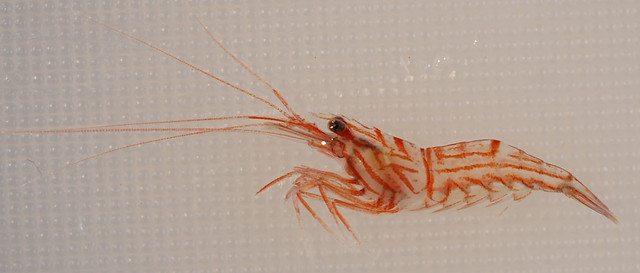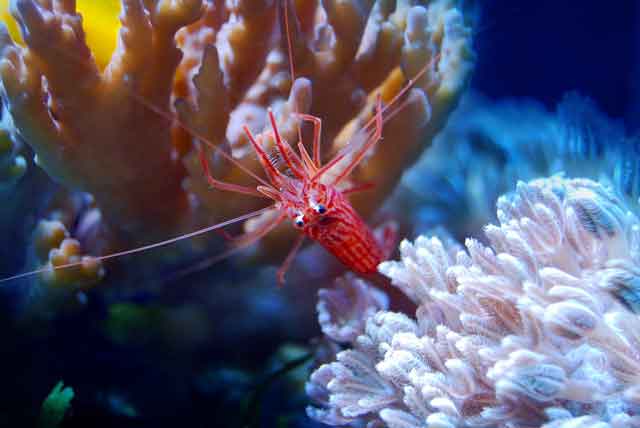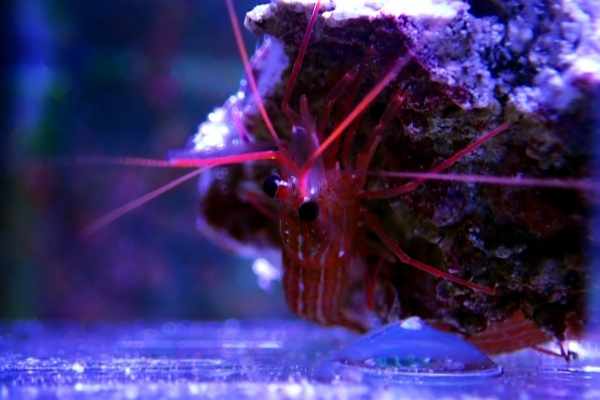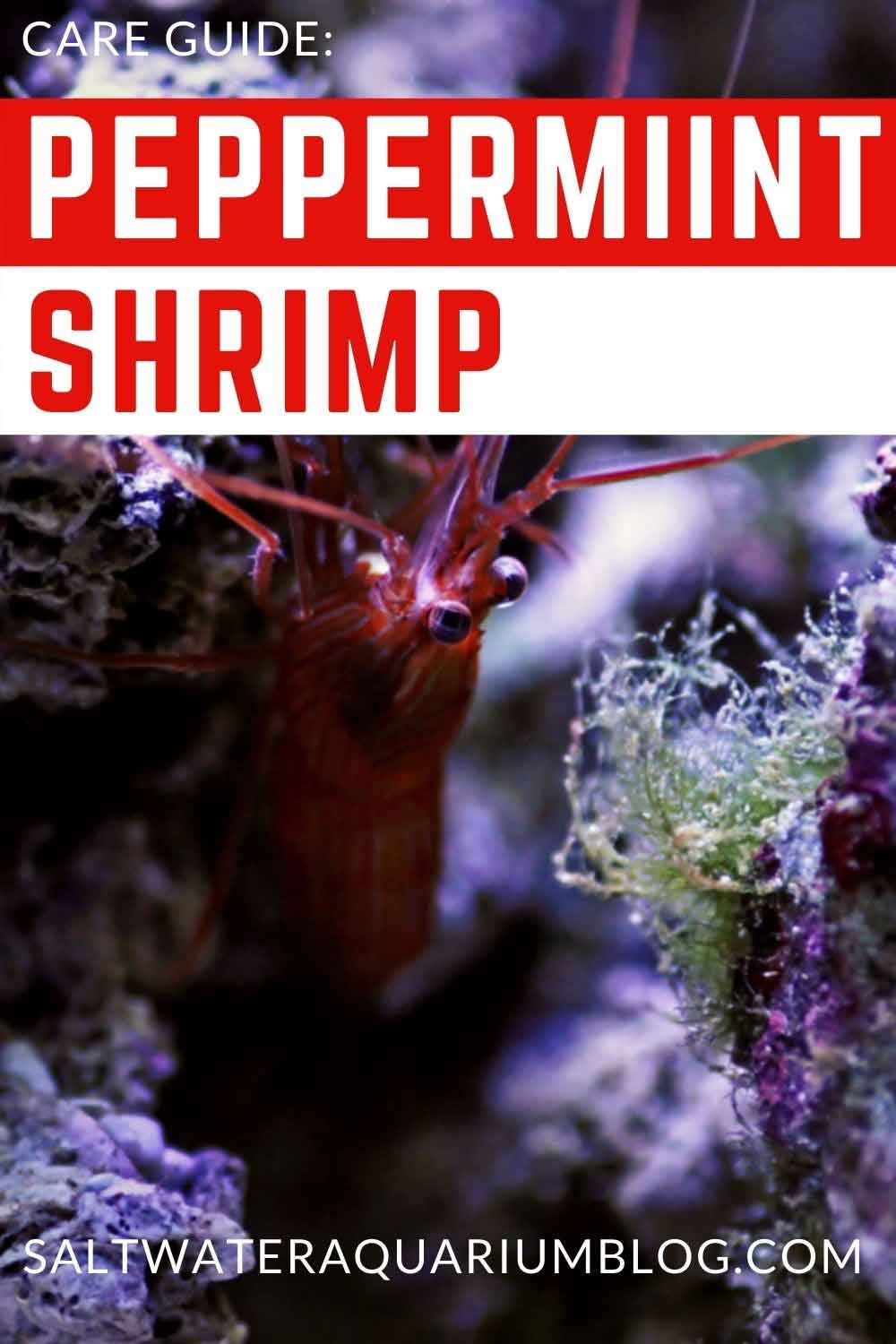Peppermint shrimp (Lysmata wurdemanni) are brightly colored, inexpensive saltwater reef shrimp species often recommended to help control Aiptasia anemone populations. But they’re also fun, engaging, easy-to-care-for invertebrates that add color and variety to your reef tank. If you’ve never considered these crustaceans before, let’s dive a bit deeper into their quirks, how to care for them, what they’re compatible with – and whether or not you can add them to your reef tank.
Table of Contents: Peppermint Shrimp
You may or may not have encountered peppermint shrimp in your hunts to add invertebrates to your saltwater aquarium. Even in a quick glance through a tank, you might miss these shy tiny crustaceans. That’s where these facts on their behaviors and biology can come in handy. Once you understand them better and know what goes into their care, you’ll become fascinated with them as other hobbyists. And it’ll encourage you to take the time to pause and hunt for those little red antennae among the rocks and coral.
- Introducing the Peppermint Shrimp
- Peppermint Shrimp: Clean-Up Crew Members
- Cleaner Shrimp
- Peppermint Shrimp: Natural Aiptasia Predators
- Setting Up the Peppermint Shrimp Tank
- Feeding Peppermint Shrimp
- Compatibility with Peppermint Shrimp
- Peppermint Shrimp Reproduction
- For More Information
Introducing the Peppermint Shrimp
Peppermint shrimp pop up in fish stores under many popular names, including candy cane shrimp, Caribbean shrimp, Caribbean cleaner shrimp, and veined shrimp. All of them refer to the narrow red stripes down the pink or red bodies. (And the fact you find them throughout the Caribbean waters) They’re relatively small – around 1.5 inches (3.8cm) – and peaceful shrimp. And you usually come across them in groups hanging out around rocks and coral formations in their native ranges.
The official peppermint shrimp belong to the scientific name Lysmata wurdemanni. But you’ll also find Lysmata ankeri (the western peppermint shrimp), Lysmata boggessi, and Lysmata rafa as potential options online or in stores. They’re all technically peppermints, and they enjoy the tropical waters you find in the western Atlantic. You need to look at the pattern of their stripes to pick out the differences between the species.

If you’re looking for the pest-control aspects of peppermint shrimp (which we’ll tackle in a minute), make sure you don’t accidentally snag Lysmata californica. The red rock shrimp (or lined shrimp) looks similar, but it’s found in the eastern Pacific. It requires different water temperatures (think SUBtropical), and the invertebrate WON’T help you out with sea anemone troubles. (This is why reading those name labels gets important)
Peppermint shrimp are hardy. They come with a lifespan of up two years – with proper management. For a crustacean of their size, that’s not too shabby. And before you start to panic over care, these invertebrates aren’t difficult. Even beginner hobbyists can keep them happy. Peppermints aren’t picky eaters (which we’ll discuss). They find the majority of their nourishment throughout the tank. As long as you observe a few basics of invertebrate care, they’ll reward you with activity and color.
Peppermint Shrimp: Clean-Up Crew Members
One of the peppermint shrimp’s first – and perhaps most intriguing – behaviors is pitching in as a somewhat less traditional member of the clean-up crew. In other words, they scour your tank in search of leftover food, bits of waste, and the usual detritus that floats onto the sand and collects in the nooks and crannies of your live rock. They’re omnivores that disperse through the aquarium to keep it looking its best. And many people overlook this beneficial behavior,
After all, when I think of traditional clean-up crew members, I picture hermit crabs, cerith snails, Trochus, nassarius snails, and even serpent starfish first. I don’t think of attractive shrimp. But peppermint shrimp emerge under cover of darkness to join the rest of the invertebrates in their cleaning duties. And since they prefer to live in groups, they can accomplish plenty of work in a short period!
Add in the fact peppermint shrimp usually cost less than $10, and you have a bargain. Even a small colony won’t blow your budget. When you get a cleaner aquarium out of it, it’s worth the investment!

Cleaner Shrimp
Peppermint shrimp are technically considered to be cleaner shrimp. This means they will potentially climb over any willing fish, picking off parasites and damaged or loose scales (Sprung 2001). They set up cleaning stations in the wild. And if you have certain tangs or angelfish prone to marine ich, they might help prevent a tank-wide infestation.
However, there’s a slight caveat. Not every peppermint shrimp picks up this side of the cleaning habit. It’s hit or miss. They’re happy to clean your tank, but not every crustacean feels compelled to help their tank mates. I’ve personally never observed the behavior in my tanks. And I’ve purchased over ten of these little striped invertebrates over the years.
But the YouTube video below provides evidence they’ll happily clean a human hand. That’s essentially the same behavior (in theory, anyway).
It IS possible your peppermint shrimp may decide to help out your fish. You shouldn’t rely on the behavior, though. If you’re looking for a dedicated cleaner shrimp, you should probably consider one of the other (reliable) species out there:
Is a Peppermint shrimp a cleaner shrimp?
The Peppermint shrimp, Lysmata wurdemanni, is a saltwater cleaner shrimp species, which means they will occasionally pick parasites and dead scales off of your aquarium fish. However, this behavior is less frequently observed when compared with some other shrimp species, like the Skunk cleaner.
Peppermint Shrimp: Natural Aiptasia Predators
One of the most common reasons peppermint shrimp get added to a reef tank is because they’re natural predators of the dreaded Aiptasia sea anemones.
If you haven’t heard about Aiptasia before, they’re undesirable, rapidly reproducing hitchhikers that absolutely thrive in reef tanks. They grow so prolifically they can spread to plague proportions. And once you have them, nobody will want to swap coral frags with you. They’re contagious weeds in your tank and a pain to get rid of.
The good news is that peppermint shrimp LOVE Aiptasia. They’ll happily hunt down every last glass anemone in your aquarium. That means you don’t need to worry about looking into other (potentially toxic or dangerous) removal methods. And you’ll get to see the activity that results as the crustaceans explore the tank in search of their treat.
If you add a few peppermint shrimp to your tank, they’ll seek out and dine on the pest problem. Of course, you need to make sure you have the correct species. The Pacific cousin? They’re not interested in Aiptasia. And even some Atlantic peppermint shrimp will ignore glass anemones. If you have a group of these invertebrates, though, odds are ONE of them will decide the snack’s delightful and eradicate your unwanted visitor.

Setting Up the Peppermint Shrimp Tank
Peppermint shrimp are pretty easy to care for due to their small size and hardy nature. You can get away with a minimum tank size of just ten gallons (38L). If you’re planning to keep multiple peppermint shrimp (which you should – they’re not as shy if they’re in a group), then it’s wise to add an extra 5-10 gallons (19-38L) per shrimp. You don’t want to make things TOO crowded. While they’re social invertebrates, they WILL fight if they feel confined in their territory.
If you have an existing aquarium, you’re usually in the clear. They don’t demand any specific space, and they won’t take up a ton of volume within the tank. (Not unless you decide to bring in a monstrous group, anyway)
You should ensure the peppermint shrimp can efficiently scavenge in and around all of the structures of the tank. And you’ll want to provide some small caves to hide in during the day (remember, they’re nocturnal). They’re usually happy in tanks that include live rock as the biologically active surfaces trap detritus and offer them plenty of nooks and crannies to explore. They can work with pretty much any type of substrate without a problem. Once inside a peaceful tank, they won’t cause you much trouble.
Just keep that small size in mind. Strong filtration systems can suck them up. This is primarily a problem in smaller tanks where the shrimp get closer to the filter intake. Some sponge or netting around the opening will protect them from an accident.
Life in the Peppermint Tank
Peppermint shrimp serve as food for plenty of marine predators. So it may not surprise you to get your striped crustaceans home from the local fish store, introduce them into your tank, and then watch them vanish. These poor invertebrates have some trust issues. They’re shy – and (in case you forgot) nocturnal. Peppermints prefer the safety of shadowy ledges over open water. Once they feel safe (and the lights go down), they’ll venture out to eat and explore.
While all crustaceans possess the ability to swim – at least for short bursts – it’s not an everyday activity for peppermint shrimp. They almost always attach themselves to some structure. As such, look towards the bottom levels of your aquarium if you want to spot your peppermints.
Open water swimming was rarely observed in my tank. They reserved the bursts for rapid escapes when spooked (no primary locomotion for my shrimp).

Are Peppermint Shrimp Reef-Safe?
The Peppermint shrimp, Lysmata wurdemanni, is generally considered to be reef safe, which means that they are routinely compatible with the fish, corals, and other invertebrates kept in a community reef aquarium. They do pose some risk to LPS corals occasionally.
Most clean-up crew members don’t hassle corals. That’s what makes them ideal for keeping around in a reef tank. And in my personal experience (ten different peppermint shrimp over too many years to admit), they’ve been entirely reef-safe. As further evidence, if you read the care guides on popular websites like LiveAquaria.com, you see they indicate (at least the ORA captive-bred varieties) will not eat corals.
However – as is often the case with fish or invertebrates on the reef – the soft, fleshy polyps of some coral species end up too hard to resist. And peppermint shrimp DO have a taste for soft, squishy Aiptasia sea anemones. So you know they’re not above snacking on something with stinging cells. As such, you want to proceed with caution when you add them to your reef tank.
In fact, a quick scan on YouTube turned up several accounts of peppermint shrimp caught in the act of attacking their coral tank mates. Here’s one – front and center. You can actually see the shrimp yank out and eat the polyps!
So, buyer beware. You may find some debate at times like this as to whether the coral is already dying. Then hobbyists argue the shrimp is just “cleaning up the mess.” You may even find people discussing whether it’s a camel shrimp (they look somewhat similar) or another coral-munching species. But the unfortunate truth is peppermint shrimp can decide to sample polyps.
Monitor your crustaceans carefully.
Feeding Peppermint Shrimp
Peppermint shrimp have two modes: hiding and feeding. (Okay, so they do more than that, but it seems like that’s all they do – at least when you’re looking) They spend most of the daylight hours hiding in the cryptic or shaded areas of the tank, under rock ledges, etc. But when they emerge during the evening, they pick at the tiny morsels between coral polyps, on the rocks, in the sand – pretty much everywhere. They’re dutiful members of the cleaning crew and take their work seriously.
Unless your tank is particularly nutrient sparse (for instance, a brand new tank or an SPS tank where you need to keep nutrient levels low), peppermint shrimp will likely keep themselves well-fed. All of that detritus and leftover food will supply the ready meals they need. They’ll forage through all the spots you might miss during your scheduled cleanings. (It’s amazing how many tiny spots detritus likes to collect)
However, you should still supplement their diet to keep the group from fighting. And if you have other scavengers in your tank? Yeah, you want everyone to stay fed and healthy. Luckily, it’s easy to find them snacks:
- Commercial flakes or pellets
- Frozen brine shrimp
- Mysis shrimp

Do Peppermint shrimp eat coral?
Peppermint shrimp do not eat living coral. They will eat dying, damaged corals, and are also sometimes confused with other similar-looking shrimp species, like the camel shrimp, which will eat living corals.
Compatibility with Peppermint Shrimp
The first – and biggest – compatibility issue when keeping peppermint shrimp is to make sure shrimp aren’t on the menu of your fish. I know I enjoy the taste of shrimp, and so do most fish. It doesn’t even matter if the fish in question possesses a mouth large enough to swallow the crustacean. Some hawkfish, which have narrow “beaks,” put shrimp at the top of their dining preferences. As such, you should probably avoid these known shrimp predators:

The best tanks for peppermint shrimp have peaceful, herbivorous species. Or they at least feature planktivores and omnivores who think of shrimp as friends, not food. That means popular choices like:
Peppermint shrimp are peaceful and don’t mind sharing aquarium space with other shrimp – an unusual find in the saltwater shrimp group. Of course, you need to make sure the species you pick won’t decide to pick on THEM. They’ll also adapt to life with other invertebrates without a problem. Though, according to Sprung, they are incompatible with tridacnid clams.
Peppermint Shrimp Reproduction
Once you’ve discovered the function – and delightful form – of peppermint shrimp, you start turning your attention to breeding your colony. (Go ahead, through “for fun and profit” in there) And there’s good news on that front: Peppermint shrimp have been successfully raised in captivity. There’s even a book dedicated to the topic (how you can resist a title like that?):
Obtaining a pair of shrimp capable of breeding is relatively easy since peppermints are simultaneous hermaphrodites. This means every individual carries both male and female reproductive organs. There’s no need to look for any external differences between the two (not that there are any). It’s relatively easy to produce shrimp eggs in captivity. You may even get a shrimp carrying eggs from the store. Take a look at the swimmerets under their tail where they keep them to know for sure. You’ll spot the eggs under there and know you’ll have babies in your tank – briefly.
The babies are called larvae, and peppermint shrimp larvae appear on the menu of EVERY planktivorous fish in your tank and even the adult shrimp! In no time, they end up in someone’s stomach. Unless you make preparations, you’ll never see another peppermint. (Well, unless you buy more)
Good thing it’s possible to raise the larvae. The methods are established. You need to capture the larvae, culture your own foods (phytoplankton, rotifers, copepods, baby brine shrimp, etc.) and have a separate grow-out tank. The larvae take a little over 30 days to metamorphose into juveniles and settle in their new tank.
ORA and other aquaculture suppliers offer captive-bred peppermint shrimp if you feel the extra work isn’t worth the reward. This is an excellent (preferred) option over locally collected specimens.
What are Peppermint shrimp good for?
Peppermint shrimp are good invertebrates to add to your tank for the following reasons:
- Cleaning up uneaten food and detritus
- Eating aiptasia anemone pests
- Cleaning parasites and dead scales off your saltwater fish
For More Information
Peppermint shrimp won’t win a prize for the largest saltwater shrimp species. They aren’t even the flashiest invertebrate out there. But they’re nifty crustaceans that can pitch in as part of your clean-up crew. If you’re looking for more information – on them or another invertebrate – you’ve come to the right place.
This YouTube video walks you through everything you could want to know about the peppermint shrimp:
Or maybe you want to know about some other invertebrates – with traits as extraordinary as the peppermint shrimp:
- Berghia nudibranchs: Another natural Aiptasia predator
- Harlequin shrimp
- Pistol shrimp
- Dolabella sea hare slug
- Sexy shrimp
Conclusion
Peppermint shrimp are hardy, easy to breed crustaceans often added to saltwater aquariums to keep the population of Aiptasia anemones down. The biggest challenge you might face is picking tank mates that won’t turn your striped crustaceans into a midnight snack. Oh, and I hope you don’t get one of those peppermint shrimp who plan to snack on your LPS.
References
- Kirkendoll, April. How to Raise & Train Your Peppermint Shrimp, 2nd Edition. Lysmata Publishing. 2008
- Sprung, Julian. Invertebrates: A Quick Reference Guide. Ricordea Publishing. Miami. 2001.




Leave a Reply